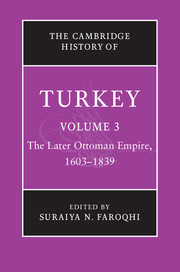Book contents
- Frontmatter
- PART I BACKGROUND
- 1 Introduction
- 2 Ecology of the Ottoman lands
- 3 Political and diplomatic developments
- PART II AN EMPIRE IN TRANSITION
- PART III THE CENTRE AND THE PROVINCES
- PART IV SOCIAL, RELIGIOUS AND POLITICAL GROUPS
- PART V MAKING A LIVING
- PART VI CULTURE AND THE ARTS
- Glossary
- Bibliography
- Index
- References
2 - Ecology of the Ottoman lands
from PART I - BACKGROUND
Published online by Cambridge University Press: 28 March 2008
- Frontmatter
- PART I BACKGROUND
- 1 Introduction
- 2 Ecology of the Ottoman lands
- 3 Political and diplomatic developments
- PART II AN EMPIRE IN TRANSITION
- PART III THE CENTRE AND THE PROVINCES
- PART IV SOCIAL, RELIGIOUS AND POLITICAL GROUPS
- PART V MAKING A LIVING
- PART VI CULTURE AND THE ARTS
- Glossary
- Bibliography
- Index
- References
Summary
Area and period
This section deals with the centuries of long-term contraction and stagnation of the Ottoman Empire, following the splendid period of Suleyman the Law-giver (1520–66). In the time-span treated here the Ottoman Empire lost several provinces situated on its fringes, while stability and security within its boundaries also declined. These two-and-a-half centuries were a period of internal stagnation, in which the empire’s connection with contemporary European developments was lost. On the Ottoman side there was hardly anything to compete with the modernisation and increasing power of Austria and later of Russia. Down to the Tanzimat period, the Ottoman Empire more or less remained a medieval state.
Nevertheless, in the 1600s the empire retained impressive power, continental extension and enormous diversity. From the northern Carpathians (southern Slovakia), the south-western Ukraine and the Caucasus, the sultans’ domains extended all the way to southern Arabia, upper Egypt and along the North African coast to Tunis and Algiers. Cool, wet mountain forests on the shores of the Black Sea and in the Balkans formed part of the realm, as did the steppes of Anatolia and Syria. Mediterranean evergreen forests extended from Albania to Greece, southern Anatolia and the Syrian coastlands. They were all part of this empire, and the same applied to the empty deserts of Arabia and North Africa.
We know the reasons for the empire’s decline in its later history. The disconnection of the Ottoman state from Europe and the latter’s modern development has often been held responsible, and the relevant arguments need not be repeated here.
- Type
- Chapter
- Information
- The Cambridge History of Turkey , pp. 18 - 43Publisher: Cambridge University PressPrint publication year: 2006
References
- 5
- Cited by



